Purchase & Tackles
A purchase is a mechanical device by means of which an applied pull or force is increased; it may be a system of levers, a system of revolving drums or wheels geared to one another, or a combination of blocks or pulleys rove with rope or chain.
A tackle (pronounced ' taycle ') is a purchase consisting of a rope rove through two or more blocks in such a way that any pull applied to its hauling part is increased by an amount depending upon the number of sheaves in the blocks and the manner in which the rope is rove through them.
Parts of a tackle
The blocks of a tackle are termed the standing block and moving block; the rope rove through them is called the fall, which has its standing, running and hauling parts. The size of a tackle is described by the size of its fall; a 3-in. luff, for example, would be rove with a 3-in. fall.
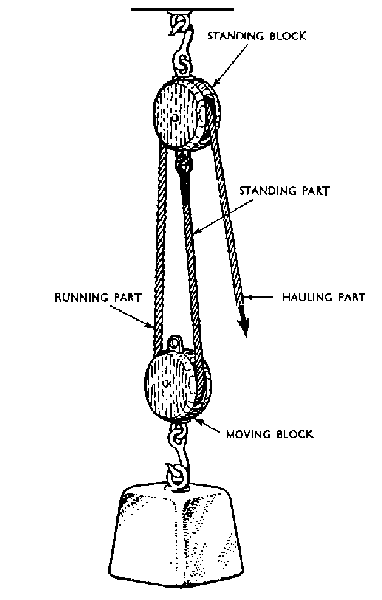
[ FIG. 1. Parts of a tackle ]
Mechanical Advantage
The amount by which the pull on the hauling part is multiplied by the tackle is called its mechanical advantage (M.A.) and, if friction is disregarded, this is equal to the number of parts of the fall at the moving block. In fig.2 for example, there are two parts at the moving block, therefore the mechanical advantage is two; in other words, a pull on the hauling part of I cwt would, if friction were disregarded, hold a weight of 2 cwt.
Friction, which occurs in the bearings of the sheaves and in the fall as it bends round the sheaves, reduces the mechanical advantage considerably; this loss through friction is explained later on.
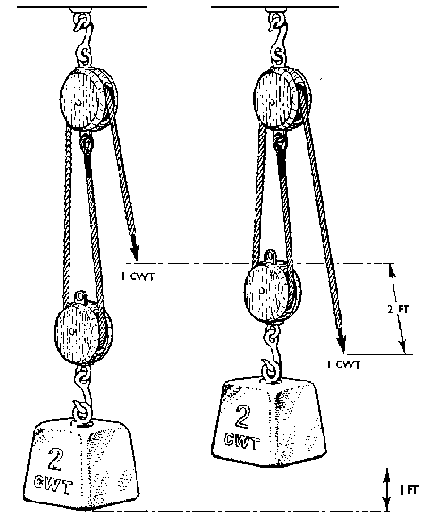
[ FIG. 2. Mechanical advantage and velocity
ratio of a tackle ]
Velocity ratio
Mechanical advantage is gained only at the expense of the speed of working. In fig. 2, for example, the weight will only be raised one foot for every two feet of movement of the hauling part. The ratio between the distance moved by the hauling part and that moved by the moving block is known as the velocity ratio (V.R.) and is always equal to the number of parts of the fall at the moving block.
Reeving a tackle to advantage and to disadvantage
The number of parts at the moving block, and therefore the mechanical advantage, is always greater when the hauling part comes away from the moving block, and such a tackle is said to be rove to advantage. Conversely, a tackle in which the hauling part comes away from the standing block is said to be rove to disadvantage (see fig. 3). Where practicable, therefore, rig a tackle so that the hauling part leads from the moving block, and make the block with the greater number of sheaves the moving block.
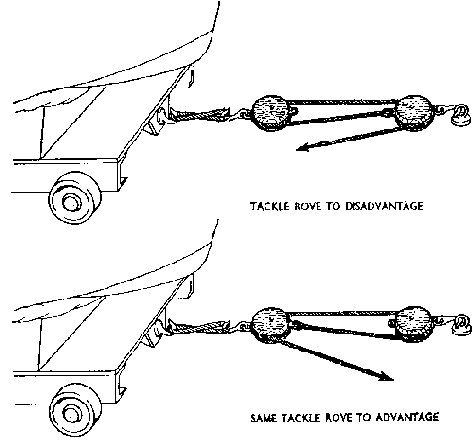
[ FIG. 3. Reeving a tackle to advantage and
to disadvantage ]
Load on the standing block
The load on the standing block, and therefore on the fitting to which it is attached, is dependent upon the mechanical advantage of the tackle used. This load is calculated by adding the pull required on the hauling part to the weight which is being moved; and so for a given weight the greater the mechanical advantage the less will be the load on the standing block.
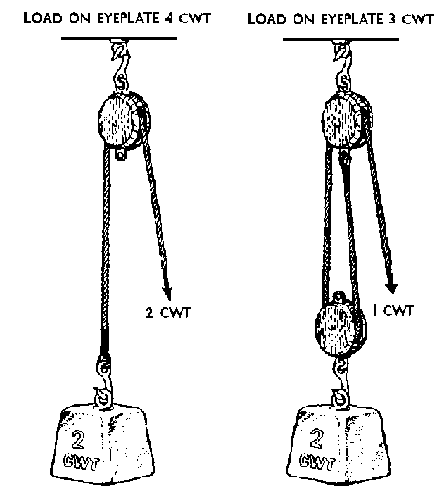
[ FIG. 4. Load on the standing block ]
EXAMPLES OF TACKLES AND PURCHASES
Examples of whips, tackles and purchases used at sea, together with their velocity ratios and mechanical advantages, are given below; in each the approximate loss of mechanical advantage due to friction has been taken into account.
Single Whip
This consists of a fall rove through a single standing block; no mechanical advantage is gained. It is used for hoisting light loads, and where speed of hoisting is an important factor.
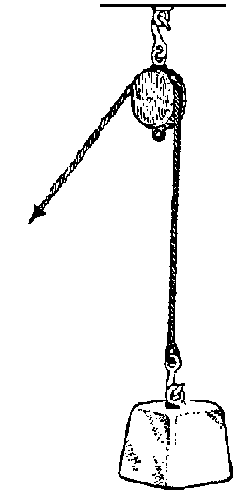
[ FIG. 5. Single Whip ]
Runner
This consists of a rope rove through a single moving block. As there are two parts of the fall in the moving block, the V.R. is 2 and its M.A. is 1.82.

[ FIG. 6. Runner ]
Double Whip
This is a purchase used for hoisting and consists of two single blocks with the standing part of the fall made fast near, or to, the upper block, and it cannot be rove to advantage. Its V.R. is 2 and its M.A. is 1.67.
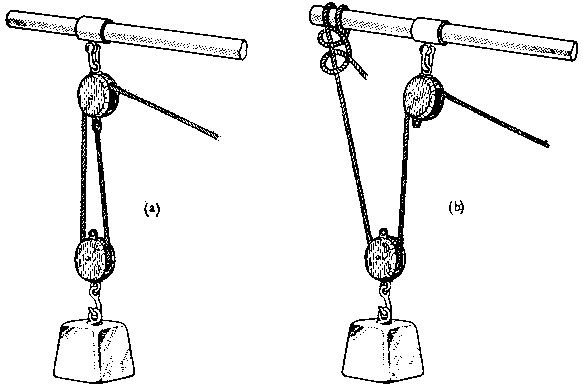
[ FIG. 7. Double Whip ]
Gun Tackle
This is the term usually applied to a purchase consisting of two single blocks, but which is not used for hoisting; it cannot then be called a double whip (fig. 7), as this term is applied only when it is used for hoisting. In the gun tackle the standing part of the fall is always made fast to one of the blocks. The name originates from the small tackle which was used to run out the old muzzle-loading gun carriages after they had recoiled. The V.R. is 3 if rove to advantage, and 2 if rove to disadvantage, and its M.A. is 2.5 and 1.67 respectively.

[ FIG. 8. Gun Tackle ]
Luff
This is a purchase of 3-in. in size or greater. It consists of a double and a single block, with the standing part of the fall made fast to the single block. Its V.R. is 4 if rove to advantage (see fig. 3), and 3 if rove to disadvantage (see fig. 3), and its M.A. is 3.08 and 2.3 respectively.
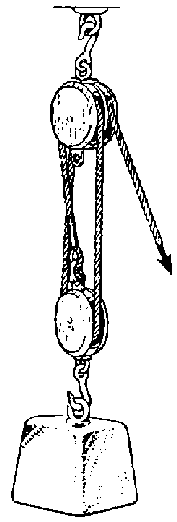
[ FIG. 9. Luff ]
Jigger
This is similar to a luff (see fig. 9), but of from 2-in. to 2.5-in. in size.
Handy billy
This is a small tackle of less than 2-in. in size; it is usually rove as a jigger but can be rove as a small gun tackle (see fig. 8).
Two-fold purchase
This consists of two double blocks and is a useful general-purpose tackle. Its V.R. is 5 if rove to advantage, and 4 if rove to disadvantage, and its M.A. is 3.57 and 2.26 respectively.
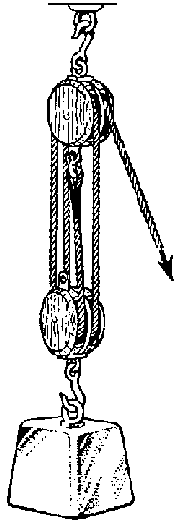
[ FIG. 10. Two-fold purchase ]
Three-fold purchase
This consists of two treble blocks; its V.R. is 7 if rove to advantage (see fig. 3), and 6 if rove to disadvantage (see fig. 3), and its M.A. is 4.37 and 3.75 respectively. It is used mainly in boats' falls.
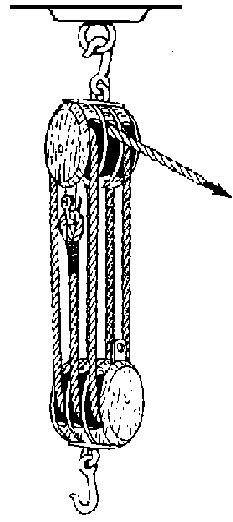
[ FIG. 11. Three-fold purchase ]
Tackles having more than three sheaves to a block, such as the four-fold, five-fold and six-fold purchases, are not provided as upper deck tackles because they are too cumbersome to handle efficiently and because the friction in their sheaves considerably reduces their gain in mechanical advantage. If additional mechanical advantage is required it is better to combine two simple tackles.
Luff upon luff
This is a general term used to describe the combined use of two tackles in which the moving block on one is clapped on to the hauling part of the other; its mechanical advantage is the product of the mechanical advantage of each tackle. Fig. 12 shows two luffs rove to advantage and as a luff upon luff, whose V.R. = 4 x 4 = 16; its M.A. is 9.49.

[ FIG. 12. Luff upon luff ]
Runner and tackle
This is a tackle with its moving block made fast to the hauling part of a runner. The velocity ratio of the runner and tackle illustrated is 2 x 4 = 8, and the mechanical advantage is 1.82 x 3.08 = 5.61.
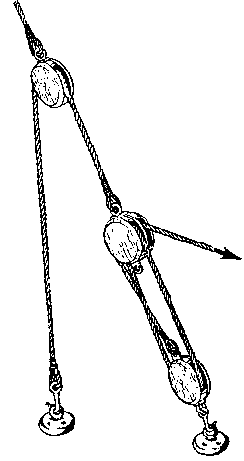
[ FIG. 13. Runner and tackle ]
Five-part or three-and-two tackle
This consists of one triple and one double block, the standing part being made fast to the double block. This tackle is found in H.M. ships and is sometimes used in boats' falls.
Dutchman's purchase
This is a tackle used in reverse to take advantage of the velocity ratio of the tackle; an example of its use is to drive a light whip at a fast speed from a slow but powerful capstan. In the example illustrated in fig. 14, the whip would move a distance of 5 ft for every foot travelled by the moving block. When using a tackle in this manner the pull exerted by the capstan must be equal to the product of the weight to be hoisted and the velocity ratio of the tackle, plus the friction in the tackle and its leading blocks; in this case a pull of at least 5.6 times the weight to be hoisted. Make sure that the tackle and its pendant are strong enough for the job.
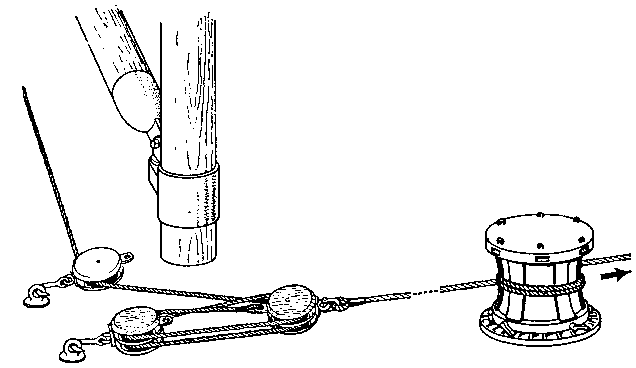
[ FIG. 14. Dutchman's purchase ]
Friction in a tackle
When a tackle is being worked considerable friction is set up, both in the bearings of the blocks and within the fall as it bends round the sheaves. This friction accounts for the difference between the velocity ratio of the tackle and its mechanical advantage, as shown in the examples of tackles already described. The general approximate rule for estimating the amount of friction is to allow from one-tenth to one-eighth of the weight to be hoisted for each sheave of the tackle according to whether the tackle is well made and in good condition or of poor quality and badly maintained.
To estimate the pull required on the hauling part of any tackle to hoist a given weight, divide the weight by the mechanical advantage of the tackle. Conversely, the weight which can be hoisted by a given pull on the hauling part of a tackle can be found by multiplying the pull by the mechanical advantage of the tackle.
When holding or lowering a load with a tackle, the friction will take part of the weight, and the force required on the hauling part is less than that required to hoist the load.
NOTES
(i) The above statements are approximate and no block should be used for lifting loads greater than the safe working load shown on it unless special approval has been obtained.